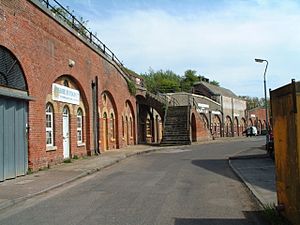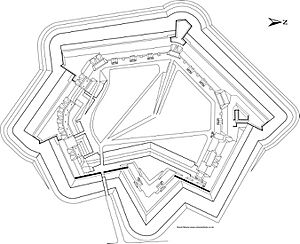Fort Fareham facts for kids
Quick facts for kids Fort Fareham |
|
|---|---|

The north face of the derelict west caponier at Fort Fareham
|
|
| Type | Palmerston Fort |
| Location | Gosport |
| Area | Hampshire |
| Built | 1861–1868 |
| Owner | Fareham Urban District Council |
| Lua error in Module:Location_map at line 420: attempt to index field 'wikibase' (a nil value). | |
Fort Fareham is a historic military fort located in Fareham, England. It is one of the famous Palmerston Forts, which were built to protect Britain from possible attacks. This fort was constructed between 1861 and 1868. It was designed to fill a gap in the defenses between the forts on Portsdown Hill and the Gosport Advanced Line. Fort Fareham has been a Grade II Listed Building since 1976, meaning it's an important historical site.
Contents
What is Fort Fareham?
Fort Fareham is positioned west of Salterns Creek, right next to the railway line. This railway line, which runs from Fareham to Gosport, was also part of what the fort protected. The fort was built about 3,500 yards (about 2 miles) ahead of Fort Elson. Fort Elson was the northernmost fort in the Gosport Advanced Lines.
Why was Fort Fareham Built?
Fort Fareham was a key link between the forts on Portsdown Hill. You could see it from Fort Wallington, which was about 2,500 yards (1.4 miles) away. The important town of Fareham and Fareham Creek were located between these two forts. Fort Fareham also helped protect the road connecting Gosport to the Portsdown Forts. Because of its isolated spot and the need to protect the area in front of the Gosport Lines, Fort Fareham was built to defend itself strongly. Its position made it very risky for an enemy to attack the Gosport Lines without first capturing or disabling Fort Fareham.
How was Fort Fareham Designed?
The fort has a five-sided shape, like a pentagon. The main guns were placed on the rampart facing west. Another rampart on the north side had guns to control the "Fareham gap" towards Fort Wallington. The ramparts to the south were more exposed to enemy fire. To protect them better, the guns there were hidden inside special structures called Haxo casemates. Fort Fareham is unique among the Palmerston Forts for having so many of these Haxo casemates.
The fort is surrounded by a ditch. This ditch was supposed to be filled with water. However, it was hard to keep water in it, so the northern part often stayed dry. The ditch was well protected by a large structure called a grand caponier on the west side. Smaller demi-caponiers were at the north, southwest, and south corners. Later in its construction, it was decided to close the back of the fort with a "redan" instead of a self-contained "keep." A keep is like a strong tower, similar to those found in the inner Gosport forts.
Fort Fareham's History
Fort Fareham has a long and interesting history, from its construction to its modern-day uses.
Building the Fort (1861-1868)
The construction of Fort Fareham took seven years, from 1861 to 1868. The total cost was £104,557, which was a huge amount of money back then! A report from 1869 said that Fort Fareham was "skillfully constructed." It was built to be strong and permanent. The report also stated that once finished, it would be ready for modern weapons. It was expected to offer good resistance to any attack, especially if its ditch was filled with water.
Fort Fareham in Action (1868-1902)
When the fort was first designed, it was meant to hold many guns. These included 49 7-inch R.B.L. guns. Five 64-pounder R.M.L. guns were also planned for the main west rampart. These 64-pounders were later changed to 7-inch R.B.L. guns. They were to be mounted on special Moncrieff counterweight carriages. These carriages could hide the guns after firing. The fort also had three rifled howitzers and fifteen smooth bore guns. These smaller guns were for defending the ditches.
By the time the fort was finished, its weapons had been updated. It had 64 7-inch R.B.L. guns, five 40-pounder R.B.L. guns, and five 64-pounder R.M.L. guns. There were also fifteen 32-pounder S.B.B.L. guns in the caponiers. Three Rifled Howitzers were also part of its defense. By 1891, most of the planned weapons were in place. This included fifteen 7-inch RBL guns. Ten of these were in emplacements on the main and south ramparts. Five guns were in the Moncrieff Gun Pit. Ten movable guns were also available to cover the Fareham Gap.
Later Uses of the Fort (1902-1965)
Around 1902, most of the land forts like Fort Fareham were no longer needed for defense. Their weapons were removed. Fort Fareham then became a barrack, providing housing for soldiers. It served this purpose until after the Second World War.
In 1905, plans called for Fort Fareham to be occupied by soldiers. These soldiers would use the fort as a base. Their job was to meet any attack from the west. This was based on the idea that an enemy might capture or march around Southampton. The fort also stored movable weapons. These weapons were to be used in the Fareham gap if needed. By 1908, the 1st Heavy Brigade was stationed at Fort Fareham. After 1900, new buildings were added. These included stables, a harness room, and a vehicle shed. They were built next to the west gun ramp.
During World War I, in 1914, the 35th (Heavy) Battery of the 1st Heavy Brigade Royal Garrison Artillery was at the fort. They were sent to join the British Expeditionary Force in France. Later, in December 1914, two more siege brigades were formed at Fort Fareham.
In World War II, in 1941, Fort Fareham was used as a headquarters. It was the main base for the 124 Heavy Anti Aircraft Regiment, Royal Artillery. It also served as headquarters for several anti-aircraft batteries. From 1928 to 1945, the Officers’ Mess building was the HQ for the 35th Anti-Aircraft Brigade. It also served as the Gun Operation Room. After the war, from 1947 to 1957, it was used as part of an Anti-Aircraft Operations Room.
Fort Fareham Today (1965-Present)
In 1965, the fort was no longer needed by the military. The Ministry of Defence sold it to the Fareham Urban District Council. A few years later, in 1974, a company leasing the fort caused significant damage. They bulldozed the ramparts, removing earth from the Haxo casemates. One Haxo casemate was completely removed. The guard room, gateway, and other buildings were also torn down. Luckily, an order stopped further damage.
Today, the main area of the fort is covered by the Fort Fareham Business Park. The old casemates are still there but have been turned into modern industrial units. During the Cold War, the main magazine and a nearby caponier were used as Fareham Borough Emergency Centre. This was a secret place for the Council in case of a nuclear attack.
In 2012, the ramparts were overgrown and hard to reach. The gun positions had been removed. The five Moncrieff pits are still visible. The Haxo casemates are intact but have been bricked up. The mortar battery and caponiers are mostly ruined and overgrown. The main west caponier has a lot of damage to its brickwork. A big fire in 1989 also damaged the inside roof arches. The openings for guns and entry points have been blocked to stop vandals. The iron railings of the access bridge are still there. The ditch around the fort was partly cleared in the late 1980s. The surrounding wooded area now forms a wild ground. It is managed by Fareham Council. There are paths with seats around the outer edge of the ditch for people to walk.



